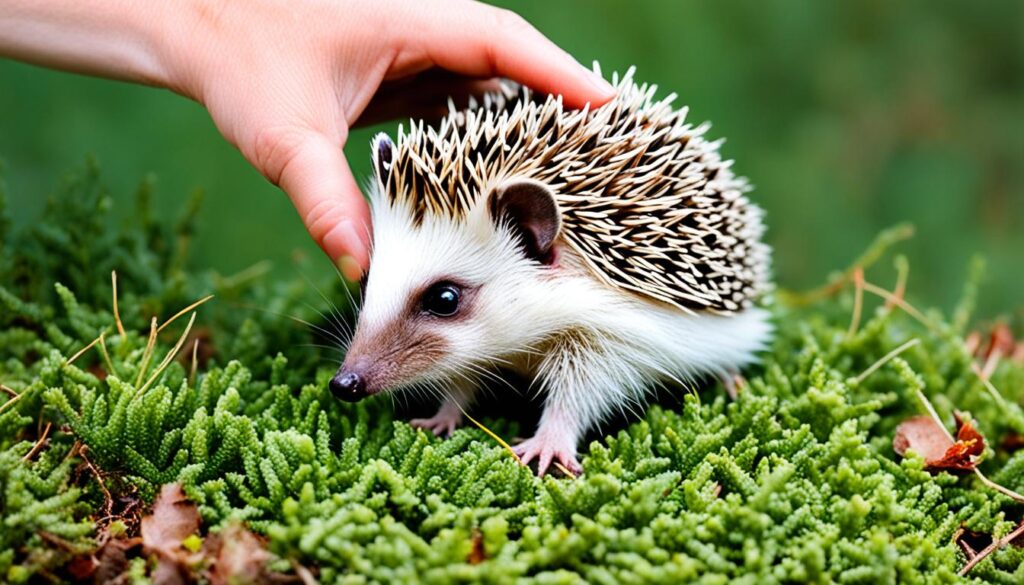Did you know that hedgehogs have over 5,000 sharp needles on their backs? These adorable little creatures may seem harmless, but their spiky exterior can actually cause some discomfort. In addition to their prickly quills, hedgehogs also have a reputation for biting. So, before you bring home one of these enchanting pets, it’s essential to understand the risks and learn how to ensure their safety as well as your own.
Key Takeaways:
- Hedgehogs have sharp quills that can cause itching, rash, and discomfort when they come into contact with their owner’s skin.
- While hedgehogs can bite, it is rare and usually occurs when they are young or feel threatened.
- Understanding the reasons behind hedgehog biting behaviors and implementing appropriate training and handling techniques can reduce the likelihood of being bitten.
- Proper hygiene, such as handwashing and regular cleaning of their habitat, can help minimize the risk of contracting diseases from hedgehogs.
- By taking precautions and being observant of their behaviors, you can have a safe and enjoyable experience with your prickly pet.
Reasons For Hedgehog Bites
Hedgehogs are generally docile creatures, but there are several reasons why they may resort to biting. It is essential to understand these reasons to ensure a safe and harmonious interaction with your hedgehog.
Situations That May Trigger Hedgehog Bites:
- Feeling threatened or scared: Hedgehogs have a natural instinct to defend themselves when they feel threatened or frightened. If they perceive a potential danger, they may resort to biting as a means of protection.
- Experiencing pain or illness: A hedgehog in pain or discomfort may lash out and bite when approached or handled. It’s important to be aware of any signs of pain or illness in your hedgehog and seek appropriate veterinary care.
- Encountering strong smells or tastes: Hedgehogs rely heavily on their sense of smell, and strong odors or tastes on a person’s skin may trigger a defensive response, causing them to bite.
- Agitation or aggression: Like any living creature, hedgehogs can become agitated or aggressive, especially if they feel their boundaries are being invaded. Aggressive behaviors, such as snarling or hissing, may precede a bite.
- Protecting their territory: Hedgehogs are territorial animals and may bite if they feel their space is being invaded or threatened. They may perceive new people or animals as intruders and resort to biting as a protective measure.
Understanding the reasons behind hedgehog bites can help you anticipate potential triggers and take appropriate precautions to prevent biting incidents. By creating a safe and comfortable environment for your hedgehog and respecting their boundaries, you can foster a positive and trust-based relationship.
Recognizing Behaviors That Can Lead To Hedgehog Bites
When interacting with hedgehogs, it’s important to be aware of certain behaviors that may indicate a potential bite. By recognizing these behaviors, we can take the necessary precautions to prevent hedgehog bites and ensure our safety.
Body Language Indicators
Hedgehogs have unique body language cues that can give us insights into their mood and potential for biting. Some behaviors to watch out for include:
- Posturing stiffly: Hedgehogs may stand on their hind legs and puff up their quills when feeling threatened or defensive.
- Quick repositioning: If a hedgehog quickly changes its position to keep an eye on you, it may be signaling its wariness or discomfort.
- Aggression: Growling, hissing, or lunging are indicators of aggression and might be a precursor to biting.
- Search for an escape route: Hedgehogs may become restless and try to look for a way to escape if they feel cornered or trapped.
It’s crucial to familiarize ourselves with these body language cues to better understand the hedgehog’s feelings and respond accordingly. By respecting their boundaries and providing them with space when needed, we can minimize the risk of bites.
Signs of Discomfort or Distress
Hedgehogs that are experiencing pain, illness, or injury can be more prone to biting. As responsible caretakers, we should be observant of any signs of distress, such as:
- Unusual vocalizations: Whining, whimpering, or constant squealing could indicate discomfort or pain.
- Changes in eating or drinking habits: Loss of appetite, excessive thirst, or difficulty eating may suggest an underlying health issue.
- Lack of activity: If a normally active hedgehog becomes lethargic or loses interest in its surroundings, it could be a sign of illness.
- Visible injuries: Wounds, sores, or limping should be assessed and treated promptly to alleviate any pain or discomfort.
By being attentive to these indicators, we can address any potential health concerns and create a comfortable environment for our hedgehogs, thus reducing the likelihood of bites.
Creating a Safe Environment
Providing an appropriate habitat for hedgehogs can also contribute to their overall well-being and minimize the risk of aggressive behaviors. Here are some essential environmental considerations:
- Proper temperature and bedding: Maintaining suitable temperature levels and using appropriate bedding materials help hedgehogs feel comfortable and secure.
- Ample hiding spots: Hedgehogs need places to retreat and feel safe, such as tunnels, caves, or hideouts.
- Stress-free interactions: Avoid sudden movements, loud noises, or crowded environments that might startle or overwhelm the hedgehog.
By implementing these environmental factors, we can create a stress-free space where hedgehogs are less likely to feel threatened or resort to biting as a defense mechanism.

Overall, recognizing the behaviors and indicators that may lead to hedgehog bites is crucial for promoting a safe and enjoyable interaction with these delightful pets. By understanding their body language, being vigilant about signs of distress, and creating a suitable environment, we can foster a harmonious bond with our hedgie companions.
Ways To Handle Hedgehog Biting
When it comes to handling hedgehog biting, there are several effective techniques that can be employed. By understanding the reasons behind their biting behaviors and implementing appropriate strategies, we can ensure the safety and well-being of both ourselves and our prickly companions.
Avoidance: One of the key ways to handle hedgehog biting is through avoidance. By recognizing when a hedgehog is in a bad mood or needs space, we can give them the necessary distance. This allows the hedgehog to feel more secure and reduces the likelihood of them resorting to biting as a defensive mechanism.
Socialization: Building trust and reducing aggression is crucial in handling hedgehog biting. Socialization plays a vital role in achieving this. By gradually introducing hedgehogs to new experiences, people, and environments, we can help them feel more at ease and decrease their tendency to bite.
Diversion and Distraction: Redirecting a hedgehog’s attention away from biting can be achieved through diversion and distraction techniques. Providing them with engaging toys, tunnels, or puzzle feeders can keep their focus away from any potential biting situations.
Positive Reinforcement: Rewarding good behavior and discouraging biting through positive reinforcement is an effective technique. By offering treats or praise when a hedgehog displays non-biting behaviors, we encourage them to associate positive outcomes with gentle interactions.
Negative Punishment: While positive reinforcement is the preferred method, negative punishment can also be used to discourage biting behaviors when necessary. For instance, implementing a timeout by placing a hedgehog in a designated separate space for a short period of time can help them understand that biting leads to a loss of social interaction.
By employing these techniques, we can effectively handle hedgehog biting, prevent any potential harm, and maintain a positive relationship with our spiky companions.
| Technique | Description |
|---|---|
| Avoidance | Recognizing when a hedgehog needs space and giving them distance |
| Socialization | Building trust and decreasing aggression through gradual introductions |
| Diversion and Distraction | Redirecting the hedgehog’s attention away from biting using engaging toys or activities |
| Positive Reinforcement | Rewarding non-biting behaviors with treats or praise |
| Negative Punishment | Implementing a timeout as a consequence for biting |
Which Method Is Best For Stopping Hedgehog Bites?
When it comes to stopping hedgehog bites, it’s important to remember that different methods may work better for different hedgehogs. Each hedgehog is unique, and understanding their behaviors and preferences is key to finding the most effective approach. Here are some strategies to help you prevent hedgehog bites:
1. Socialization and Handling Techniques
Socializing your hedgehog from a young age can help build trust and reduce aggression. Handle your hedgehog gently and regularly, using positive reinforcement to reward good behavior. Gradually introduce your hedgehog to different environments, people, and situations to help them feel more comfortable and less likely to bite.
2. Diversion and Distraction
When you notice your hedgehog exhibiting signs of potential aggression or discomfort, try diverting their attention away from biting. Offer them a treat or engage them in an activity they enjoy, like playing with a toy or exploring a safe space. By redirecting their focus, you can help prevent biting behaviors.
3. Reinforcement Training
Positive reinforcement can be an effective training method for curbing biting behaviors. Reward your hedgehog with treats, praise, or playtime when they exhibit non-biting behaviors. This will help reinforce good behavior and discourage biting. Consistency is key in this training approach.
4. Identifying Triggers and Avoidance
Pay attention to your hedgehog’s reactions and behavior to identify triggers that may lead to biting. These triggers can vary from strong smells or tastes to feeling threatened or scared. Once you identify these triggers, take steps to avoid them or minimize their impact on your hedgehog. This may involve adjusting your handling techniques or creating a calm and secure environment for your pet.
Remember, the key to stopping hedgehog bites is observing, understanding, and respecting your hedgehog’s unique needs and preferences. Consistency and patience in implementing these methods will help you establish a safe and trusting relationship with your hedgehog.

Incorporating these effective methods into your interaction with hedgehogs can significantly reduce the risk of bites. By prioritizing your hedgehog’s comfort, using positive reinforcement, and recognizing potential triggers, you can create a safe and enjoyable environment for both you and your prickly companion.
Dealing With Hedgehog Bites In The Moment
If a hedgehog bites in the moment, remaining calm and responding appropriately is crucial for both your safety and the hedgehog’s well-being. The immediate focus should be on safely separating the hedgehog from the person it has bitten.
If there are any signs of injury, it is essential to provide immediate first aid. Proper first aid can help minimize the risk of infection and promote healing. However, if the bite is severe or shows signs of infection, seeking medical attention is highly recommended.
While treating the bite, it is equally important to carefully observe the hedgehog for any signs of distress or injury. Hedgehogs may exhibit behaviors like whimpering, excessive drooling, or difficulty moving if they are injured. Being vigilant and attentive can help determine if further veterinary assistance is required.
Remember, hedgehog bites are rare, and it’s crucial to approach the situation with a calm mindset and take appropriate actions to ensure the safety and well-being of both parties involved.
| First Aid Steps for Hedgehog Bites: |
|---|
| 1. Wash the bite area gently with mild soap and warm water. |
| 2. Apply an antiseptic solution, like hydrogen peroxide, to the wound. |
| 3. Cover the bite with a clean bandage or sterile dressing. |
| 4. Monitor the wound for signs of infection (increased redness, swelling, pus, or fever). |
| 5. Seek medical attention if the bite is deep, shows signs of infection, or if you are unsure about proper wound care. |

Straight Talk About Hedgehog Bites
Hedgehog bites may not be a common occurrence, but it’s important to be prepared and take necessary precautions when handling these adorable creatures. By understanding the reasons behind their biting behaviors and implementing appropriate training and handling techniques, you can greatly reduce the likelihood of being bitten. Consistency and patience are key in promoting a safe and enjoyable interaction with hedgehogs.
Here are some important facts and considerations to keep in mind:
- Hedgehog bites are not common behaviors: While many hedgehogs are gentle and rarely bite, it’s essential to remember that they are still wild animals at their core. They have natural instincts and behaviors that may occasionally manifest as a bite.
- Preventing hedgehog bites: To minimize the risk of bites, it’s crucial to handle hedgehogs with care and respect. Always approach them calmly and avoid sudden movements. Provide a conducive environment and avoid situations that may cause stress or fear.
- Understanding biting behaviors: Hedgehogs may bite when they feel threatened, anxious, or hurt. By observing their body language and listening to their vocal cues, you can learn to recognize the warning signs and adjust your interactions accordingly.
- Proper training and handling: Consistent training is essential in establishing trust and building a positive relationship with your hedgehog. Use gentle handling techniques, provide regular socialization, and employ positive reinforcement to encourage desired behaviors.
Remember, when it comes to hedgehog bites, prevention is the key. By taking appropriate measures, respecting their boundaries, and building trust, you can enjoy a safe and rewarding experience with these fascinating creatures.
Handling Techniques to Prevent Hedgehog Bites
| Technique | Description |
|---|---|
| Avoidance | Giving hedgehogs space when they are in a bad mood or showing signs of distress. Respecting their boundaries and avoiding situations that may cause anxiety or fear. |
| Socialization | Regularly interacting with your hedgehog in a positive and calm environment. This helps build trust and reduce aggression. |
| Diversion and Distraction | Redirecting a hedgehog’s attention away from potential triggers that may lead to biting. Offering toys or treats can help divert their focus. |
| Positive Reinforcement | Rewarding good behavior with treats or praise to encourage desired actions and discourage biting. |
| Negative Punishment | Using timeout or withdrawal of attention as a consequence for biting behavior. Consistency is crucial in reinforcing the message that biting is not acceptable. |
By implementing these handling techniques and being attuned to your hedgehog’s needs, you can create a harmonious bond and reduce the likelihood of bites.

Conclusion
In conclusion, while hedgehogs have the potential to bite, it is a rare occurrence. By understanding the reasons behind their biting behaviors and implementing appropriate strategies, we can help prevent bites and ensure pet safety. It is important to handle hedgehogs with care, using gloves for protection, and practicing good hygiene to minimize the risk of infection. Moreover, being observant of their behaviors and learning their body language can help create a positive and enjoyable bond between hedgehog and owner.
By taking proper precautions, such as avoiding situations that may agitate or frighten the hedgehog, we can have a safe and fulfilling experience with these adorable prickly pets. Remember, consistency, patience, and positive reinforcement are key in training hedgehogs to reduce biting behaviors. Together, we can foster a loving and trusting relationship with our hedgehog companions.
So, if you’re considering a hedgehog as a pet, don’t let the fear of biting deter you. With knowledge, understanding, and responsible pet ownership, we can create a harmonious and safe environment for both ourselves and our hedgehog friends. Happy hedgehog parenting!
FAQ
Do hedgehogs bite?
What are the reasons for hedgehog bites?
How can I recognize behaviors that may lead to hedgehog bites?
What are some ways to handle hedgehog biting?
Which method is best for stopping hedgehog bites?
How should I respond to hedgehog bites in the moment?
Are hedgehog bites common?
What is the key takeaway about hedgehog bites?
Is a Hedgehog’s Unique Traits Related to Their Tendency to Bite?
Understanding hedgehog unique traits is crucial when it comes to their tendency to bite. Hedgehogs may bite due to fear, feeling threatened, or unease. Their quills and nocturnal habits are unique traits that can impact their behavior. Proper handling and creating a safe environment can reduce the likelihood of bites.










